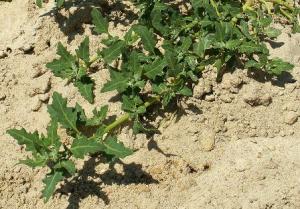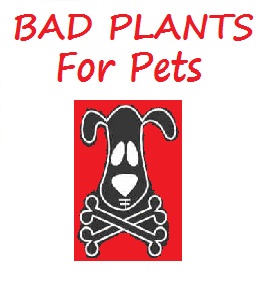Oak-Leaved Goosefoot

The leaves and seeds of all members of this genus are more or less edible. As a result this genus has a long history of human use both as a food source and medicinal herb. The Native American people of northwestern Mexico would steep Chenopodium leaves into a super concentrated decoction for the treatment of fevers and to remove intestinal worms. Whereas the Navajo would use members of the genus as part of a poultice to treat bruises and skin irritation. Native Americans also learned that the long taproot of Chenopodium californicum could be dried, stored and grated for use as soap. Even today many species are still gathered from the wild and cooked as potherbs, some species are also cultivated for their seeds, which have low gluten content and can be cooked similarly to rice and yet others have found use as culinary herbs.
These plants, however, can be toxic and in fact quite deadly to humans and livestock alike under the right circumstances. The potential toxic ability these plants is not so much the result of the inherently lethal chemicals that they produce naturally, as it is the result of the environmental factors present during their growth. It is true that many species in this genus contain oxalates, saponins and cyanogenic glycosides; substances that in other species of plant can naturally occur in potentially lethal amounts. In this genus, however, under healthy growing conditions, the amounts are usually in quantities too small to do any harm and to be of significance toxicologically. It is the ability of plants in this genus to uptake and hold excess nutrients (specifically nitrate) in response to adverse growing conditions or environmental stress that can make them toxic to the point of being lethal.
A quick primer on the nitrogen cycle as it relates to plant growth. Plants take nitrogen from the soil, by absorption through their roots in the form of either nitrate ions or ammonium ions. All nitrogen obtained by animals can be traced back to the eating of plants at some stage of the food chain. If nitrate is absorbed, it is first reduced to nitrite ions and then ammonium ions for incorporation into amino acids, nucleic acids, and chlorophyll; all of which are essential for plant growth. Under normal conditions the conversion of nitrate takes place at about the same rate that it is absorbed by the root system so its concentration in plant tissues will remain low. When plants are stressed, however, excess nitrate accumulation can be triggered; especially in times of drought where plant growth is restricted but absorption of nitrate from soil continues. Under normal conditions it can be expected that plants will have safe nitrate levels of under 4400 ppm, whereas plants that have suffered severe environmental stress can achieve nitrate levels as high as 70,000 ppm. Amounts over 15,000 ppm are considered to have serious potential for toxicity (University of Wisconsin), although cattle have become intoxicated when fed well-fertilized hay with nitrate concentrations as low as 8250 ppm nitrate (Ozmen et. al 2003). Other factors that can contribute to the accumulation of excess nitrate include extended periods of reduced sunlight from cloudiness or shading, injury from temperatures below 32°F which causes ice crystals form on plant leaves, extended periods of low growing temperature, acidic soils, deficiencies of essential nutrients (phosphorus, sulfur, molybdenum), and certain herbicides including 2,4-D and 2,4,5-T. It is also possible for plants to accumulate nitrate in the absence of environmental stress when more soil nitrogen is present than needed for maximum growth as would be the case in excessively fertilized soil.
Ruminants (cattle, goats, sheep) are the most likely to be affected by plants containing high levels of nitrates. When a ruminant ingests nitrates, the bacteria in the rumen convert the nitrate, to nitrite (which is 10 times more toxic than nitrate), and finally to ammonia. The ammonia is then converted to urea and either recycled to the digestive tract to form bacterial protein allowing the cycle to repeat as many times as necessary to continually convert incoming nitrate or voided in the urine. In the rumen, the reduction of nitrate to nitrite is a rapid process, whereas the detoxification of nitrite and subsequent conversion to ammonia is a much slower one. If overwhelmed, however, the rumen, unable to convert the excess nitrate at a level commensurate with its intake will allow both nitrate and nitrite to be absorbed directly through the rumen wall and into the bloodstream causing the toxicity.
Once in the bloodstream the excess nitrite will combine with hemoglobin in the red blood cells oxidizing its ferrous iron into the ferric state forming methemoglobin, which is incapable of transporting oxygen. A normal non intoxicated animal will have methemoglobin values in the range of 1 to 3 percent of hemoglobin content, but severely intoxicated animals can have levels upwards of 70 percent. Thus, when an animal dies from nitrate poisoning, it is due to multiple organ failure as a result of oxygen deprivation. The excess nitrate in the bloodstream does not, in and of itself, create toxicity problems, but can contribute to the overall syndrome when it is recycled back into the rumen via saliva or gastro-intestinal secretions where it will be converted to more toxic nitrite and reabsorbed into the bloodstream.
Nitrate reduction (and nitrite production) also occurs in the cecum (hindgut) of equids (horses, donkeys etc.), but not to the same extent as in ruminants. As a result horses are generally much more tolerant of high concentrations of nitrate. In fact nitrate poisoning is horses is considered to be very rare and is more often associated with exposure to fertilizer spills than it is with grazing on plants containing high nitrate levels.
Nitrate poisoning in ruminants can be either an acute or subacute condition and in many cases the first indication of a problem will be the discovery of a dead animal in the field. This is due to the fact that affected animals may die suddenly without appearing ill within an hour of ingesting high nitrate forage. In other cases clinical signs may persist a few hours to a few days preceding death; most often culminating in terminal anoxic convulsions due to lack of oxygen to the brain.
In most cases the symptoms of nitrate poisoning will appear suddenly as a result of tissue hypoxia and low blood pressure due to vasodilation. In the early stages of intoxication, when methemoglobin levels begin to exceed 20%, vaginal and other mucous membranes may turn from pink to a gray-brown as a result of tissue hypoxia. As the nitrite continues to be released into the blood, the levels will continue to rise. At 30 to 40 percent animals may exhibit a rapid, weak heartbeat with subnormal body temperature, muscular tremors, weakness, and ataxia (lack of voluntary coordination of muscle movements). The freshly drawn blood from an animal afflicted with nitrate poisoning will often be a dark chocolate-brown color. Once the total methemoglobin content exceeds 50%; dyspnea (air hunger/gasping), tachypnea (rapid breathing), anxiety, and frequent urination are common; seizures and death are also a likely possibility. Monogastric animals (with a single-chamber stomach such as humans, dogs, cats, horses rabbits etc.) which usually suffer intoxication from nonplant sources such as fertilizers or contaminated water may exhibit depression, inappetance, hypersalivation, moderate to severe gastrointestinal upset (vomiting, diarrhea, abdominal pain) gastric hemorrhage and possibly death.
Some animals may not exhibit adverse effects until after they have eaten high nitrate forages for days to weeks at which point the progression from clinical signs to death may be rapid. Severely intoxicated animals that develop marked dyspnea may recover only to then develop interstitial pulmonary emphysema and continued respiratory distress; many of these will recover fully within 1 to 2 weeks.
Unfortunately, the symptoms of cyanide poisoning are very similar to those of nitrate toxicity. In cases where livestock may have had access to pasture containing plants known to be a source of cyanogenic glycosides like Triglochin maritima (arrow grass), Hoecus lunatus (velvet grass), Sorghum spp (Johnson grass, Sudan grass, common sorghum), Prunus spp (apricot, peach, chokecherry, pincherry, wild black cherry), Sambucus canadensis (elderberry), Pyrus malus (apple), Zea mays (corn), and Linum spp (flax), one must determine whether nitrate or cyanide is the culprit. In the field the simplest test is to draw fresh blood, cyanide contaminated blood will generally turn a brilliant cherry red upon exposure to air, whereas methemoglobin contaminated blood will be dark brown or chocolate in color.
Nitrate accumulation also has an effect on a plants accumulation of oxalate. A number of studies have shown that nitrate can efficiently induce the accumulation of high levels of oxalates in plants. Although, how it does this is not well understood. Typically the concentrations of oxalates are 1-2%, however, nitrate accumulation can result in oxalate accumulation in excess of 20%. As a plant matures oxalate levels in the leaves will increase while the levels in the stems will decrease. Signs of oxalate intoxication may occur abruptly a few hours following the consumption of contaminated plants, and animals may die within 12 hours. There is typically a progression of symptoms from depression, weakness, tremors, weak pulse, and labored respiration to prostration, coma, and death in a few hours.
Prevention is the best medicine, if you are unsure of a plants nitrate content have it tested. If plants have been subjected to drought condition or other unusual stresses, have forage samples tested before allowing animals to graze the area.
References:Ozmen O, Mor F, and Ayhan U (2003) Nitrate poisoning in cattle fed Chenopodium album hay. Veterinary and Human Toxicology 45:83-84.
University of Wisconsin “Nitrate Poisoning In Cattle, Sheep and Goats”; Dan Undersander, Dave Combs, Randy Shaver, and Dave Thomas
Nitrate Toxicity: Diagnosis and Treatment; Robert Smith, DVM and Glenn Selk
Avoid further ingestion of the plant and consult a veterinarian. When nitrate toxicity occurs, rapid diagnosis and prompt treatment are necessary to prevent severe mortality loss. Methylene blue is the principal therapeutic agent for nitrate toxicity. By reducing the ferric iron in hemoglobin to the ferrous state, methylene blue rapidly converts non oxygen carrying methemoglobin to hemoglobin allowing the blood to once again accept and transport oxygen to the vital organs of the body.
The suggested dose is 4-30 mg/kg body weight administered slowly via intravenous injection of a 1 to 4 percent solution as soon as clinical signs are identified. The treatment may be repeated if clinical signs recur. The treatment interval should be no less than 20-30 minutes. Although effective methylene blue is not approved for use on animals intended for food. Additionally the stress of gathering and restraining animals with severe methemaglobinemia so treatment can be administered may in some cases further worsen their condition.
The use of mineral oil (1 L/400 kg) orally as a cathartic has been suggested to help speed defecation thus lessening the time high nitrate material remains in the gastrointestinal tract and is available for conversion to nitrite.
Identification and removal of the suspected source of nitrate should also be undertaken to prevent reoccurrence. If treatment is prompt and continues for sufficient time and the high nitrate source can be removed, the prognosis will range from good to guarded, although abortions may still occur for up to a week or more.




